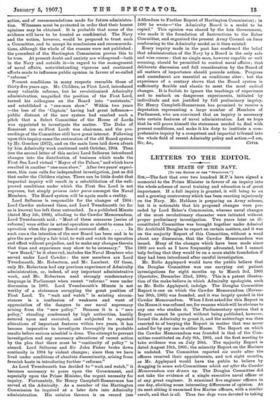LETTERS TO THE EDITOR.
THE STATE OF THE NAVY.
[To THE EDITOR or Tex “Srrmror.")
SIB,—The fact that over two hundred M.P.'s have signed a memorial to the Prime Minister in favour of an inquiry into the whole scheme of naval training and education is of great importance. If a full inquiry is granted, it will bring to an end a growing controversy which has been reacting injuriously on the Navy. Mr. Haldane is preparing an Army scheme, but it is noticeable that his proposed changes were pre- ceded by Lord Esber's Commission, whereas naval changes of the most revolutionary character were initiated without proper preliminary investigation. Two years later an ill- constituted Committee was brought together under Admiral Sir Archibald Douglas to report on certain matters, and it was on the majority Report of this Committee, without a word about any dissension, that the Cawdor Memorandum was issued. Many of the changes which have been made since 1902- are such as I have frequently advocated, but I cannot help feeling that they would be on a more stable foundation if they had been introduced after careful investigation.
Mr. Rollo Appleyard would have the public believe that the Douglas Committee was one carrying out patient investigations for eight months up to March 3rd, 1900 (Spectator, December 22nd, 1906). This is a patent illustra- tion of the make-believe in which Admiralty apologists, such as Mr. Rollo Appleyard, indulge. The Douglas Committee Report is one on which the Cawdor Memorandum (Novem- ber 30th, 1905) was founded, and it was largely quoted in the Cawdor Memorandum. When I first asked for this Report in the House it was refused me, for reasons which will be obvious to any one who studies it. The Parliamentary system that a Report cannot be quoted without being published, however, forced the Admiralty to grant it, and the subterfuge was then resorted to of burying the Report in matter that was never asked for by any one in either House. The Report on which the Cawclor Memorandum was founded is that of the Com- mittee constituted on July 8th, 1905, and the first meeting to take evidence was on July 20th. The majority Report is dated August 18th, 1905; the minority Report on the Marines is undated. The Committee reported six weeks after the officers received their appointments, and not eight months, as Mr. .Appleyard would have the public to , believe by dragging in some sub-Committees which sat after the Cawdor Memorandums was drawn :up. The Douglas Committee did not fake the evidence of a single executive naval officer or of any, great engineer. It examined five engineer officers in one day, eliciting some interesting differences of opinion. At its next sitting it examined five Marine officers, with a similar result, and that is all. Thus two days were devoted to taking
evidence for a Report of which the Cawdor Memorandum says "The Report which is dimmed in detail in a separate note, has convinced the Board that there will be no need for a final division into the three branches, and that specialisation for a period only is necessary, as opposed to permanent classifica- tion into separate lines." It then devoted a couple of days to the Royal Corps of Naval Constructors. Finally, on the fifth day it polished off the four thousand artificers and twenty- nine thousand stokers in connexion with watchkeeping duties in the engine-room by taking the evidence of a chief artificer engineer, who was frankly hostile to the scheme, and a leading stoker, who was favourable. Smart work indeed for five days ! Contrast Sir William White's Committee on Engineer- ing Training. Compare the constitution of this great Com- mittee, the patient investigation for a long period, the two hundred and seventy witnesses, and the unanimous points of agreement, especially as to the age at which engineering train- ing should commence. Inquiry will show whether the late Board of Admiralty were right ; but public confidence is so shaken by methods such as the Douglas Committee that inquiry is a matter of vital necessity.—I am, Sir, &c., CABLYON BELLAIRS.















































 Previous page
Previous page